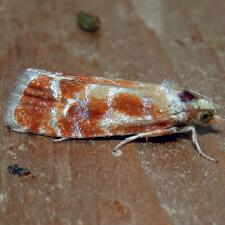Map Snapshot



















21 Records
Status
Introduced to North America from Europe more than 100 years ago (Bugguide).
Relationships
Larval host plants include Loblolly Pine and other pines (Gilligan, Wright, & Gibson, 2008).
Seasonality Snapshot
Source: Wikipedia
| Rhyacionia buoliana | |
|---|---|

| |

| |
| Mounted female | |
| Scientific classification | |
| Domain: | Eukaryota |
| Kingdom: | Animalia |
| Phylum: | Arthropoda |
| Class: | Insecta |
| Order: | Lepidoptera |
| Family: | Tortricidae |
| Genus: | Rhyacionia |
| Species: | R. buoliana
|
| Binomial name | |
| Rhyacionia buoliana | |
| Synonyms | |
| |
Rhyacionia buoliana, the pine shoot moth, is a moth of the family Tortricidae. It is native to North Africa, North Asia, and Europe, and invasive in North America and South America.


The wingspan is 16–24 mm. The forewings are ferruginous-orange, often partly suffused with dark red and with several irregular variable anastomosing metallic grey-whitish striae and costal strigulae. The hindwings are light grey. The larva is brown-reddish; head and plate of 2 black.[2]
Adults are on wing from June to August in western Europe.
The larvae feed on pine. The original host plants are Pinus sylvestris and Pinus nigra.
Subspecies
[edit]- Rhyacionia buoliana
- Rhyacionia buoliana thurificana (Lederer, 1855)
Parasites
[edit]The larvae are attacked by the tachinid fly Actia nudibasis.[3]
References
[edit]- ^ tortricidae.com
- ^ Meyrick, E., 1895 A Handbook of British Lepidoptera MacMillan, London
- ^ Belshaw, Robert (1993). "Tachinid Flies Diptera Tachinidae". Royal Entomological Society Handbooks. 10 (4ai). Royal Entomological Society of London: 170.
External links
[edit]
